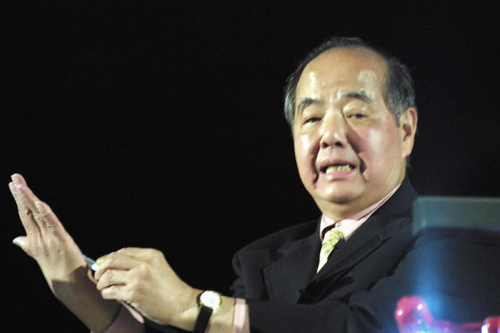|
|


ADVERTISEMENT
Buy Your own advertising
spaces!
.
Download Adobe Acrobat Reader to open [PDF] files.
Recent Visitors
Tsung-Dao Lee:Exploring 'dark' mysteries
2010. 21 March
 Tsung-Dao Lee, born in 1926 in Shanghai, is a Chinese-born American physicist who shared the 1957 Nobel Prize in Physics with C.N. Yang for their discovery that weak interactions between elementary particles violate parity laws. Lee, who earned his doctoral degree at the University of Chicago, was the second-youngest Nobel laureate when he won the prize at age 31. He is the recipient of numerous prestigious awards and continues research as a professor of theoretical physics at New York's Columbia University.
Tsung-Dao Lee, born in 1926 in Shanghai, is a Chinese-born American physicist who shared the 1957 Nobel Prize in Physics with C.N. Yang for their discovery that weak interactions between elementary particles violate parity laws. Lee, who earned his doctoral degree at the University of Chicago, was the second-youngest Nobel laureate when he won the prize at age 31. He is the recipient of numerous prestigious awards and continues research as a professor of theoretical physics at New York's Columbia University.
(english.eastday.com)
Our earth is not a big planet in the solar system, and the sun does not stand
out from the rest of the 400 billion stars in the whole galaxy which also looks
very tiny in the universe. However, thanks to our ancestors who created the
Chinese civilization, this planet blessed with brown earth and blue water
cherishes more distinctive features with greater intelligence and better human
ethics than any other parts of the universe. Chinese
Version>>
Although my tight schedule has
restrained my knowledge about World Expo 2010 Shanghai China, I believe its
greatest importance as a pageant of human civilization lies in its exposition of
how the human race living on this planet has constantly moved forward in its
exploration of the world and the universe.
World Expo 2010 Shanghai China
will be the first comprehensive global exposition hosted by a developing
country. For a developing nation like China, hosting this World Expo in 2010 is
not only an effort to build a platform for cooperation between countries across
the world but also a great opportunity to further strengthen its exchange with
other nations. Through this opportunity, the Chinese nation will closely
communicate with other cultures and learn from them.
The World Expo is a
stage for exhibiting scientific and technological applications. Over the past
150 years, many new achievements in science, technology, ideology and culture
have born a relationship with the World Expo.
It was through the World
Expo that major inventions like automobiles, televisions, electric lamps and
elevators made their debuts and started to gain popularity. As far as I know,
this World Expo will showcase many original technological achievements made in
Shanghai and in China as a whole, which have grown out of the efforts by
generations of scientists in fundamental research.
How shall we Chinese
keep coming up with new achievements in the decades after this event?
As
I see it, China cannot afford to miss the 21st century in the field of
fundamental research.
In the past, China missed the 17th century
symbolized by classical mechanics, the 18th and 19th centuries represented by
electro-magnetism, and the 20th century epitomized by quantum physics and the
theory of relativity. Now, it cannot afford to miss the 21st century. The
development of physics in the new century is closely correlated with "known
substances," "dark matter" and "dark energy."
According to the research
results we have achieved so far, the energy of the known substances consisting
of such particles as electrons, protons and neutrons as well as a very small
number of positrons and antiprotons only accounts for 5% of the total energy of
the universe, with the remaining 95% coming from unknown substances, including
approximately 22% from dark matter and 73% from dark energy.
We can
realize the existence of dark matter from the effects of gravity, and discern
the existence of dark energy from the acceleration of cosmic inflation.
To understand and investigate dark matter and dark energy pose the
greatest challenges in modern physics. We Chinese must engage ourselves in these
fields.
Some people may doubt China's ability to lead the world in these
fields. I would like to list two examples to clear their doubts. Nova and
supernova, two very important concepts in astrophysics, were both first
discovered by Chinese.
We discovered a nova back in the 13th century BC
(during the Shang Dynasty), and a supernova in the Song Dynasty. To their
surprise, the Chinese scientists of that time noticed a shining star in daytime,
which looked "as big as an egg."
They recorded its luminance every day
for a whole year. These records are among the earliest astronomical observations
in the world. Given the remarkable contributions by our ancestors, I strongly
believe that modern Chinese scientists can also make outstanding achievements
through persistent devotion and unfaltering patience.
Source: english.eastday.com


